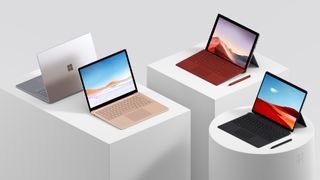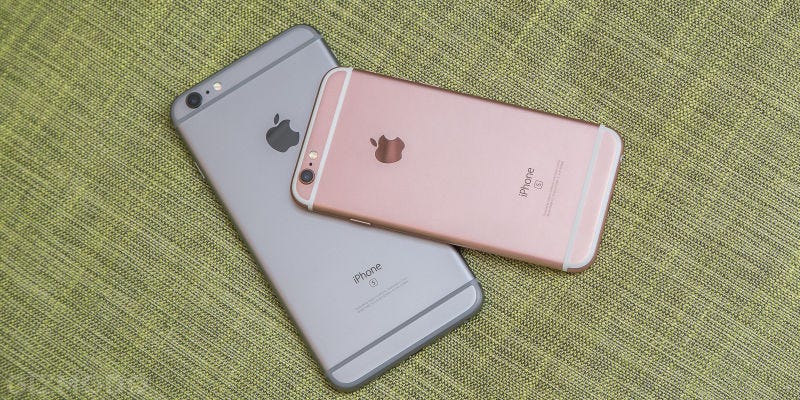Microsoft's Surface Duo is more than just a phone.
MicrosoftWhen Microsoft announced its return to making its own phones on Wednesday, offering its first take on smartphones since its $7 billion purchase of Nokia went up in smoke four years ago, the software giant said a lot of the things you'd expect. It talked about how its new dual-screen Surface Duo device, coming next year, would make us more productive. The device's dual 5.6-inch screens, whose price we don't yet know, would more effortlessly blend the computer and phone worlds.
"We think of these not just as products, but the beginning of a new category, dual-screen computing," Yusuf Mehdi, corporate vice president for Microsoft's modern life, search and devices group, said in an interview. "We're in the beginning of a new wave of innovation."
But that magical device wasn't going to be powered by some variant of Microsoft's monopoly-making Windows software, which runs on nearly 8 out of every 10 computers around the world. Instead, the Surface Duo would be powered by Google's Android, the world's most popular mobile operating system which runs on three out of every four phones.
"If you're going to have a device that fits in your pocket, and you can do phone calls and you want to run apps ... it made sense for us to choose" Android, Mehdi said.
With that, Microsoft acknowledged what we've seen for years. The once vibrant mobile software market of a decade ago, with devices powered by software from Nokia, BlackBerry, Danger, Palm and Microsoft has been decimated by Apple and Google. The only real competitors to Android and Apple's iOS left are side projects like Tizen from Samsung, which still relies on Android in its flagship phones. There's also HarmonyOS, a last-ditch effort from Chinese tech giant Huawei to ease reliance on Google's American-made software.
Microsoft's move to Android may not be as surprising, because it makes sense. Android is even more widely used in the tech world than even Microsoft's Windows, according to data from Statcounter's data, which shows that Android overtook Windows in May.
And in case you're curious, Microsoft told reporters it'll stick with Android for the foreseeable future.
"It shows Microsoft being smart -- going and competing where they think they can compete" like with a camera app, email and search, said Carolina Milanesi, an analyst at Creative Strategies. "There's a lot going for them at the moment."
Long time coming
Microsoft, which became one of the most popular companies on the planet because of its software, has been building up to this moment for half a decade.
The signs started showing in 2014, when Microsoft announced free-to-download versions of its popular Office (Word, Excel, PowerPoint) software for Apple and Google-powered devices. Microsoft made its move shortly after naming Satya Nadella its new CEO. He's staked his career on tearing down the company's once-toxic corporate culture and abandoning the old corporate ethos that everything it cared about ran Windows.
"You join here not to be cool, but to make others cool," Nadella said in an interview last year. "It's the result that matters."
Over the last few years, Microsoft's made further strides particularly with Android. One app, Your Phone, mirrors information from an Android phone to a Windows PC, allowing people to drag and drop photos to sync between them, respond to text messages on the computer and even control the phone from your computer.
As Microsoft was working on those efforts, in 2015 it admitted the buyout of Nokia was essentially worthless a year after paying for it, and cut 7,800 positions.
"We are moving from a strategy to grow a standalone phone business to a strategy to grow and create a vibrant Windows ecosystem that includes our first-party device family," Nadella said at the time.
Microsoft was praised for Windows Phone's unusual design. But it never could attract many app developers.
Dave Cheng/CNETWhat he didn't say was how poorly Microsoft's well-regarded Windows Phone software actually sold. Windows Phone was released in 2010 as a touchscreen-capable followup to Windows CE from 1996 and Windows Mobile in 2000, both of which were designed for pen-based pocket computers.
With Windows Phone, Microsoft had a do-over, offering a wholly different design from Apple and Google. One example: Microsoft's departure from the typical rows of apps we see on a typical home screen. Windows Phone instead had boxes with app icons that moved up and down to reveal glimpses of information (like news headlines) running across them.
What Microsoft couldn't do was convince app developers to build for its phones in addition to Apple and Google.
"The app selection for Windows phone is still very limited," CNET's Andrew Hoyle wrote in a 2015 review of one of Microsoft's last phones. "I'd have to say that unless you're a die-hard Windows fan (and why would you be?) then you'd have a better mobile experience from Android or iOS."
Hoping to lead
Microsoft's Surface, with its keyboard cover, helped to change the way we think of tablets. Can Duo change the way we think of phones?
Sarah Tew/CNETMicrosoft's Surface-branded devices offer a chance for a restart.
The company's laptop and tablet designs are praised as innovative, for example. And Microsoft's efforts to expand into headphones scored a thumbs up from CNET's audio expert David Carnoy.
"The Microsoft Surface Headphones are what you'd hope for in a premium noise-canceling headphone," he said after an exclusive first hands-on with them last year, though he criticized Microsoft's less-capable Cortana voice assistant when compared to those from Google and Apple. (Even then, Microsoft's listened -- strengthening ties between Cortana and Amazon's popular Alexa in the past year.)
With a surface-branded phone, Microsoft is hoping it can offer a compelling spin on the emerging folding-phone craze, highlighted by Samsung's troubled $2000 Galaxy Fold and Huawei's as-yet unreleased Mate X. Microsoft's Surface Duo is powered by two screens that interact with one another, rather than relying on Samsung and Huawei's approach with a single larger screen that's folded in half.
"This product brings together the absolute best of Microsoft, and we're partnering with Google to bring the absolute best of Android in one product," Microsoft Product Chief Panos Panay said of the Surface Duo during Wednesday's event. "This is industry-pushing technology."
Whether that turns out to be true will depend on what happens in the next year. Microsoft said its Surface Duo phone, and its larger non-phone cousin the Surface Neo, won't arrive until next year. It plans to use that time to work with app developers to create unique programs for the device.
"Microsoft is one of the only companies who has the resources to do this," said Patrick Moorhead, an analyst at Moor Insights & Strategy, who spoke to me from a Samsung Galaxy Fold phone he'd been using. He intends to grab a Surface Duo when it comes out next year too, in part because he believes it will help usher in a new class of dual-screen phones "It's the ability for it to be a decent experience is what they're offering," he added. "The Surface team has proven that they get it."
CNET's Shara Tibken contributed to this report.
https://www.cnet.com/news/microsofts-embrace-of-googles-android-software-is-bigger-than-its-new-phone/
2019-10-05 12:00:13Z
52780401429341






